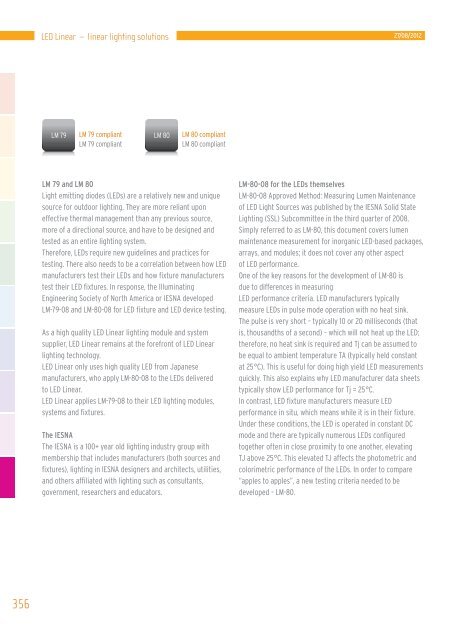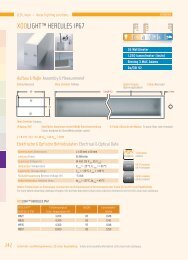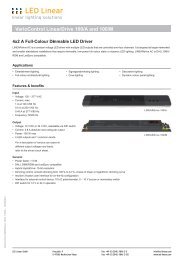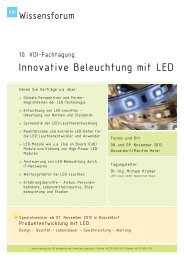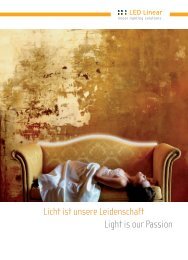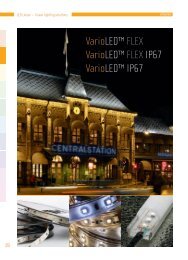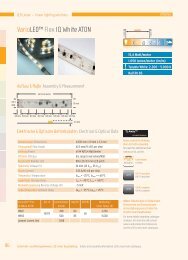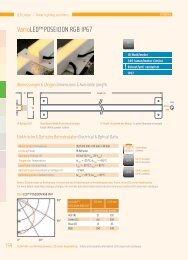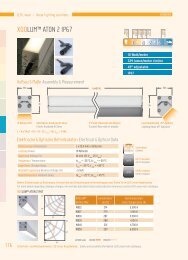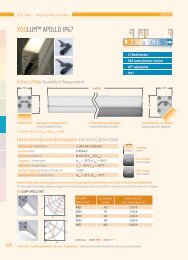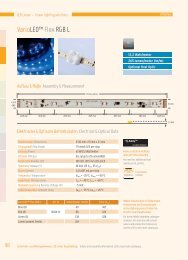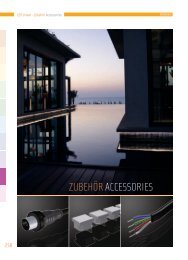- Page 1 and 2:
Licht ist unsere Leidenschaft Light
- Page 3 and 4:
12/09/2012 Inhaltsverzeichnis Conte
- Page 5 and 6:
12/09/2012 Inhaltsverzeichnis Conte
- Page 7 and 8:
12/09/2012 Inhaltsverzeichnis Conte
- Page 9 and 10:
12/09/2012 LED Linear - linear ligh
- Page 11 and 12:
27/08/2012 Licht ist unsere Leidens
- Page 13 and 14:
12/09/2012 VarioLED POSEIDON Dimmba
- Page 15 and 16:
12/09/2012 OCEANOS XOOLUM XOOLUX TM
- Page 17 and 18:
27/08/2012 VarioLED Flex W - Hellig
- Page 19 and 20:
27/08/2012 Leistungsdichte/ Power D
- Page 21 and 22:
12/09/2012 Schutz gegen elektrostat
- Page 23 and 24:
27/08/2012 Hohe Farbwiedergabe, hoh
- Page 25 and 26:
27/08/2012 Outdoor Linear Lighting
- Page 27 and 28:
27/08/2012 Gewährleistung LED Line
- Page 29 and 30:
27/08/2012 VarioLED Inhalt Content
- Page 31 and 32:
27/08/2012 VarioLED Flex Tape Portf
- Page 33 and 34:
13/09/2012 VarioLED Flex - LED Flex
- Page 35 and 36:
Foto Picture: Ailon Gavish VarioLED
- Page 37 and 38:
27/08/2012 Ausschreibungstext Vario
- Page 39 and 40:
27/08/2012 VarioLED ECONOMY IP67 Ab
- Page 41 and 42:
27/08/2012 Ausschreibungstext Vario
- Page 43 and 44:
VarioLED BASIC White IP67 18 Abmess
- Page 45 and 46:
27/08/2012 VarioLED Flex SV W863 Au
- Page 47 and 48:
VarioLED SOL IP67
- Page 49 and 50:
180° 27/08/2012 Flex ATON 2 W827 A
- Page 51 and 52:
27/08/2012 VarioLED ATON 2 IP67 Var
- Page 53 and 54:
180° 27/08/2012 lex ATON Plus W827
- Page 55 and 56:
27/08/2012 VarioLED ATON Plus IP67
- Page 57 and 58:
White_Sol_W850_Vsh.ldt Ausschreibun
- Page 59 and 60:
VarioLED Flex ATON 2 in Vario- Cont
- Page 61 and 62:
Flex SOL L W835 180° 27/08/2012 Au
- Page 63 and 64:
180° 100 200 300 150° 0° 30° cd
- Page 65 and 66:
LED Linear Lighting 1,000 Plus Appl
- Page 67 and 68:
Flex APOLLO W835 180° 27/08/2012 A
- Page 69 and 70:
LED Linear Lighting dedicated to pr
- Page 71 and 72:
lex HERKULES W835 180° 27/08/2012
- Page 73 and 74:
LED Linear lighting inspired by nat
- Page 75 and 76:
D Flex ZEUS W835 180° 27/08/2012 A
- Page 77 and 78:
LED Linear lighting solutions
- Page 79 and 80:
Polardiagramm Basic 2700 to 5700K a
- Page 81 and 82:
27/08/2012 VarioLED IQ White BASIC
- Page 83 and 84:
xWhite_Sol_W850_Vsh.ldt Ausschreibu
- Page 85 and 86:
LED Linear lighting Invited to play
- Page 87 and 88:
Polardiagramm on 2200 to 5000K adju
- Page 89 and 90:
VarioLED Flex ATON
- Page 91 and 92:
LED Flex RGB S 180° 27/08/2012 Aus
- Page 93 and 94:
27/08/2012 VarioLED RGB S IP67 Vari
- Page 95 and 96:
180° 27/08/2012 LED Flex RGB S Aus
- Page 97 and 98:
27/08/2012 VarioLED RGB 2S IP67 Var
- Page 99 and 100:
LED Flex RGB L 180° 27/08/2012 Aus
- Page 101 and 102:
27/08/2012 VarioLED RGB L IP67 Vari
- Page 103 and 104:
27/08/2012 VarioLED Flex RGB SV Aus
- Page 105 and 106:
VarioLED Flex RGB L IP67 with Vario
- Page 107 and 108:
D BASIC Color G 180° 27/08/2012 Au
- Page 109 and 110:
27/08/2012 VarioLED BASIC Color (B,
- Page 111 and 112:
asi Color R IP67 179 180° 27/08/20
- Page 113 and 114:
27/08/2012 VarioLED BASIC Color (R,
- Page 115 and 116:
ED Flex ATON R 180° 27/08/2012 Aus
- Page 117 and 118:
27/08/2012 VarioLED ATON Color IP67
- Page 119 and 120:
22/08/2012 VarioLED Flex VENUS/PHOB
- Page 121 and 122:
22/08/2012 LED Linear - linear ligh
- Page 123 and 124:
22/08/2012 Jurybegründung Es ist v
- Page 125 and 126:
lex Venus W827 244 Ausschreibungste
- Page 127 and 128:
Venus SV IP67_W840.ldt Ausschreibun
- Page 129 and 130:
us TV IP67_RGB_Allcolors.ldt Aussch
- Page 131 and 132:
us SV Ausschreibungstext IP67_RGB_A
- Page 133 and 134:
enus TV IP67_Color_Blue.ldt Ausschr
- Page 135 and 136:
enus SV IP67_Color_Blue.ldt Ausschr
- Page 137 and 138:
Flex Phobos W850 Ausschreibungstext
- Page 139 and 140:
lex Venus W827 244 Ausschreibungste
- Page 141 and 142:
Polardiagramm white Ausschreibungst
- Page 143 and 144:
Polardiagramm ite 2200 Ausschreibun
- Page 145 and 146:
22/08/2012 VarioLED Flex VENUS W TV
- Page 147 and 148:
21/08/2012 VarioLED POSEIDON VarioL
- Page 149 and 150:
21/08/2012 LED Linear - linear ligh
- Page 151 and 152:
21/08/2012 Ausschreibungstext Beste
- Page 153 and 154:
21/08/2012 Ausschreibungstext Beste
- Page 155 and 156:
21/08/2012 Ausschreibungstext Beste
- Page 157 and 158:
22/08/2012 VarioLED OCEANOS VarioLE
- Page 159 and 160:
22/08/2012 LED Linear - linear ligh
- Page 161 and 162:
22/08/2012 Ausschreibungstext Speci
- Page 163 and 164:
22/08/2012 Ausschreibungstext Speci
- Page 165 and 166:
22/08/2012 Ausschreibungstext Speci
- Page 167 and 168:
22/08/2012 Ausschreibungstext Speci
- Page 169 and 170:
21/08/2012 XOOLUM XOOLUM Portfolio
- Page 171 and 172:
21/08/2012 LED Linear - linear ligh
- Page 173 and 174:
21/08/2012 XOOLUM XOOLUM IP40 IP67
- Page 175 and 176:
21/08/2012 Ausschreibungstext Speci
- Page 177 and 178:
21/08/2012 Ausschreibungstext Speci
- Page 179 and 180:
21/08/2012 Ausschreibungstext Speci
- Page 181 and 182:
21/08/2012 Ausschreibungstext Speci
- Page 183 and 184:
12/09/2012 Ausschreibungstext Speci
- Page 185 and 186:
12/09/2012 Ausschreibungstext Speci
- Page 187 and 188:
12/09/2012 Ausschreibungstext Speci
- Page 189 and 190:
12/09/2012 Ausschreibungstext Speci
- Page 191 and 192:
21/08/2012 Ausschreibungstext Speci
- Page 193 and 194:
21/08/2012 Ausschreibungstext Speci
- Page 195 and 196:
21/08/2012 Ausschreibungstext Speci
- Page 197 and 198:
21/08/2012 Ausschreibungstext Speci
- Page 199 and 200:
21/08/2012 Ausschreibungstext Speci
- Page 201 and 202:
21/08/2012 Ausschreibungstext Speci
- Page 203 and 204:
27/08/2012 XOOLUX XOOLUX IP54 Portf
- Page 205 and 206:
27/08/2012 Dimmbare lineare LED-Leu
- Page 207 and 208:
27/08/2012 Endkappen-Version/ Endca
- Page 209 and 210:
27/08/2012 Sicherheits- und Montage
- Page 211 and 212:
27/08/2012 Ausschreibungstext Speci
- Page 213 and 214:
27/08/2012 Ausschreibungstext Speci
- Page 215 and 216:
27/08/2012 Ausschreibungstext Speci
- Page 217 and 218:
27/08/2012 Ausschreibungstext Speci
- Page 219 and 220:
27/08/2012 Ausschreibungstext Speci
- Page 221 and 222:
27/08/2012 Ausschreibungstext Speci
- Page 223 and 224:
21/08/2012 XOOLIGHT XOOLIGHT Portfo
- Page 225 and 226:
21/08/2012 24 V dimmbares, lineares
- Page 227 and 228:
21/08/2012 XOOLIGHT LED Linear - li
- Page 229 and 230:
21/08/2012 Ausschreibungstext Abpen
- Page 231 and 232:
21/08/2012 Ausschreibungstext Abpen
- Page 233 and 234:
21/08/2012 Ausschreibungstext Abpen
- Page 235 and 236:
21/08/2012 Ausschreibungstext Abpen
- Page 237 and 238:
21/08/2012 Ausschreibungstext Abpen
- Page 239 and 240:
21/08/2012 Ausschreibungstext Abpen
- Page 241 and 242:
21/08/2012 Ausschreibungstext Abpen
- Page 243 and 244:
21/08/2012 Ausschreibungstext Abpen
- Page 245 and 246:
21/08/2012 Ausschreibungstext Abpen
- Page 247 and 248:
21/08/2012 Ausschreibungstext Abpen
- Page 249 and 250:
21/08/2012 Ausschreibungstext Abpen
- Page 251 and 252:
21/08/2012 Ausschreibungstext Abpen
- Page 253 and 254:
21/08/2012 Ausschreibungstext Beste
- Page 255 and 256:
21/08/2012 Ausschreibungstext Abpen
- Page 257 and 258:
21/08/2012 Ausschreibungstext Beste
- Page 259 and 260:
07/08/2012 Zubehör VarioCable ....
- Page 261 and 262:
07/08/2012 VarioConnect RGB RGB RGB
- Page 263 and 264:
07/08/2012 VarioConnect RGB RGB RGB
- Page 265 and 266:
07/08/2012 VarioConnect RGB Bezeich
- Page 267 and 268:
07/08/2012 VarioContour VarioContou
- Page 269 and 270:
07/08/2012 VarioContour LED Linear
- Page 271 and 272:
07/08/2012 VarioContour 003 Schraub
- Page 273 and 274:
07/08/2012 VarioContour 003 0° 15
- Page 275 and 276:
07/08/2012 VarioContour 005 9 mm x
- Page 277 and 278:
07/08/2012 8 mm x 19,4 mm x 29,7 mm
- Page 279 and 280:
07/08/2012 VarioContour 006 10 mm x
- Page 281 and 282:
07/08/2012 VarioContour 006 Bezeich
- Page 283 and 284:
07/08/2012 VarioContour 007 1,5 mm
- Page 285 and 286:
07/08/2012 VarioContour 008/009 60
- Page 287 and 288:
07/08/2012 VarioContour VENUS 19 mm
- Page 289 and 290:
07/08/2012 VarioOptic 10° x 50° 5
- Page 291 and 292:
07/08/2012 VarioPSU 24 V/30 W 24 V/
- Page 293 and 294:
07/08/2012 VarioPSU 24 V/36 W 12 V/
- Page 295 and 296:
07/08/2012 VarioPSU 12 W/12 V 1 A 2
- Page 297 and 298:
07/08/2012 VarioControl BI 230 VAC
- Page 299 and 300:
07/08/2012 VarioControl BI 230 VAC
- Page 301 and 302:
07/08/2012 VarioControl BI 230VAC 2
- Page 303 and 304:
07/08/2012 VarioControl IP20 Bezeic
- Page 305 and 306: 07/08/2012 VarioControl IP20 Bezeic
- Page 307 and 308: 07/08/2012 VarioControl IP20, DALI,
- Page 309 and 310: 07/08/2012 VarioControl IP65 Bezeic
- Page 311 and 312: 07/08/2012 XOOLUX TM 2 m 140 mm 340
- Page 313 and 314: 07/08/2012 LED Linear Muster Sets L
- Page 315 and 316: 07/08/2012 LED Linear Muster Sets L
- Page 317 and 318: 07/08/2012 LED Linear Muster Sets L
- Page 319 and 320: 27/08/2012 Inhalt Installations- un
- Page 321 and 322: Notizen Notes
- Page 323 and 324: Hang in there!
- Page 325 and 326: 27/08/2012 Montagehinweise zur Vari
- Page 327 and 328: 27/08/2012 In unserer Erprobung hat
- Page 329 and 330: 27/08/2012 The lacquer APL of the c
- Page 331 and 332: 27/08/2012 • Zur Befestigung der
- Page 333 and 334: 27/08/2012 · As a further fixation
- Page 335 and 336: 27/08/2012 • Die Befestigung der
- Page 337 and 338: 27/08/2012 · There are 2 options t
- Page 339 and 340: Notizen Notes 339
- Page 341 and 342: 27/08/2012 Voltage Drop: 0,85 Produ
- Page 343 and 344: 27/08/2012 Cable length @ product l
- Page 345 and 346: 27/08/2012 Cable length @ product l
- Page 347 and 348: 27/08/2012 Cable length @ product l
- Page 349 and 350: Foto Picture: Alon Raz VarioLED ATO
- Page 351 and 352: 27/08/2012 Security and environment
- Page 353 and 354: 27/08/2012 Security and environment
- Page 355: 27/08/2012 REACH and RoHS Complianc
- Page 359 and 360: 27/08/2012 Schutzarten IP rating Ei
- Page 361 and 362: 27/08/2012 Profile Profiles Kontur
- Page 363 and 364: 27/08/2012 Allgemeine Hinweise Mit
- Page 365 and 366: 27/08/2012 Term Symbol Unit Formula
- Page 367: 27/08/2012 LED Linear stands for hi
- Page 370 and 371: Notizen Notes
- Page 372 and 373: 372 LED Linear - worldwide Head off
- Page 374: For authorized channel partner plea


